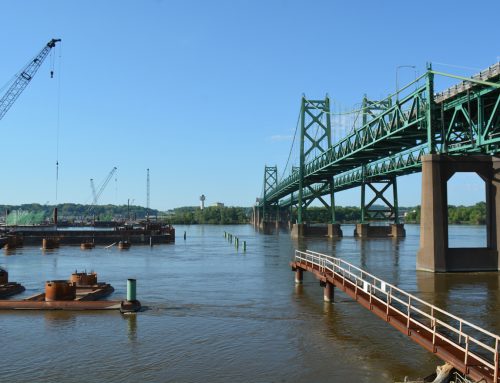Originally published in Roads & Bridges June 1, 1997
… and now it’s June 2013. Here’s an update on where each corridor is, in the order presented in the original article.
I-95 Trenton to New Brunswick
1997 Article: This may be the most heavily utilized route in the interstate system. The state of New Jersey canceled this 30 mile section of the route (Somerset Freeway) in the early 1980s. As a result, the interstate system is incomplete between New York and the Philadelphia metropolitan areas. Since the cancellation, traffic on the parallel New Jersey Turnpike has increased significantly. At the same time, development has skyrocketed along U.S. 1, in the canceled corridor. I-95 should be completed.
STATUS: I-95 will not be built and instead transferred onto the New Jersey Turnpike. Final completion of this transfer will occur when the I-95/I-276 interchange is complete and when the Delaware River bridge is twinned. Construction is scheduled through 2017.
I-11 Phoenix to Las Vegas
1997 Article: These two metropolitan areas of 2.6 million and 1.1 million population respectively are the nation’s closest large metropolitan areas without a direct interstate connection, and the cities remain among the nation’s fastest growing areas. In the future this route might be extended to the fast-growing Reno and Boise areas.
STATUS: I-11 was added as a high priority corridor and designated as a future interstate highway in 2012. Most of the route is four-lane expressway and is designated US 93. Recent improvements include the Hoover Dam Bypass. Future improvements planned include a Boulder City Bypass, new connections at Kingman, and the Hassayampa Freeway link to I-10 south of Wickenburg.
I-17 Phoenix to Salt Lake City
1997 Article: Like Phoenix, Salt Lake City is one of the nation’s fastest growing metropolitan areas with a population of 1.2 million. There is no direct interstate connection between Phoenix and Salt Lake City. Completion of this corridor would require building or upgrading approximately 300 miles of roadway from Flagstaff, Arizona, to Sevier, Utah. I-17 is completed from Phoenix to Flagstaff, while I-70 and I-15 would complete the connection to Salt Lake City.
STATUS: I-17 north has not yet gained traction with either Arizona or Utah, and most road enthusiasts view this extension as a fantasy due to the scenic value of the land through which it would traverse. While US 89 north of Flagstaff is busy and could use four-lane segments, a portion was damaged during a slide in February 2013. This resulted in a detour currently under construction along Indian Route 20. Any I-17 extension north would pass through national park and BLM lands, making the environmental impact potentially difficult to surmount. With that being mentioned, traffic volumes will increase as more people move into the SLC, Flagstaff, and Phoenix regions.
I-32 Dallas/Fort Worth to Denver
1997 Article: In the 1950s these urban areas were not among the nation’s largest. Now the Dallas/Fort Worth area has more than 4 million residents, while the Denver area has more than 2 million. The current interstate connection between these rapidly growing urban areas is indirect. This route would require 550 miles of construction, following the U.S. 287 corridor from Ft. Worth to Amarillo and connecting with I-25 in the Raton, New Mexico area. This route would also improve access from Oklahoma City to Denver. The interstate distance between Dallas/Fort Worth and Denver would be reduced by nearly 20%.
STATUS: I-32 has not been officially considered as a route number for this corridor, but Texas has been aggressively upgrading US 287 from Fort Worth to Amarillo to expressway and near-freeway configurations. Northwest of Amarillo, U.S. 87 has not been similarly upgraded. This remains a possible corridor as traffic continues to increase. The corridor is part of the Ports to Plains High Priority Corridor, and it could also be routed along US 287 north to I-70.
I-41 Houston to Corpus Christi to McAllen-Brownsville
1997 Article: McAllen-Brownsville is the largest metropolitan area not served by the interstate system, and it is one of the most rapidly growing metropolitan areas. The increased commerce under NAFTA makes this route, which serves two international ports of entry on the Mexican border, even more important. This highway is the southern extension of the proposed Mid-Continent Highway (I-69).
STATUS: The I-41 designation has been assigned to the U.S. 41 corridor between the Illinois-Wisconsin state line north of Chicago and Green Bay via Milwaukee and Appleton. The corridor described here has since been made part of Interstate 69 between Corpus Christi and Houston (via US 59) and Interstate 69E between Brownsville and Corpus Christi (via US 77). Additionally, a parallel corridor to be designated Interstate 69C was also identified via parallel US 281. These designations were made official in 2013, and signs will be added starting in summer 2013.
I-69 Indianapolis to Houston
1997 Article: This route, called the Mid-Continent Highway, would provide improved access from the Midwest to Houston, where it would connect with the proposed I-41 to the Mexican border. Approximately 600 miles would need to be built or upgraded.
STATUS: I-69 has become an elaborate, multi-segmented corridor that varies in status from state to state. I-69 does not just include I-69 from Laredo to Indianapolis. It also includes an I-x69 spur to follow Audubon Parkway in Kentucky; an extension of the I-530 spur in Arkansas (Pine Bluff to Monticello); and the creation of I-2 (US 83 in Rio Grande Valley), I-69C (US 281 from US 59 south to US 83), and I-69E (US 77 from US 59 south to US 83) in Texas.
- In Indiana, efforts to bring the corridor to completion are the strongest. The first three-mile section opened between I-64 and SR 68 on Sept 29, 2009. A 64-mile segment from SR 68 north to Crane opened on Nov 19, 2012. The 27-mile section from Crane to SR 37 near Bloomington will open in 2014. The segment north from SR 37 to I-465 will follow thereafter. A new Ohio River Bridge into Kentucky is proposed but unfunded.
- In Kentucky, I-69 was designated October 18, 2011 along its concurrent sections with I-24 and along the Western Kentucky Parkway. I-69 will be signed on the Purchase Parkway and Breathitt Parkway once they are brought up to modern Interstate standards, and the Audubon Parkway is a planned spur (I-x69). This includes a modification to the full-cloverleaf interchange between the Breathitt and Western Kentucky Parkways.
- In Tennessee, I-69 is officially recognized (but not yet signed as of summer 2013) on its concurrent segments with I-55, I-240, and I-40. I-69 will be signed on SR 300 and US 51 north of Memphis once they are brought up to Interstate standards, within ten years. The first upgrade is at Union City, with completion in 2014.
- In Mississippi, I-69 has been signed on its east-west segment (concurrent with SR 304 and opened October 3, 2006) and on its shared route with I-55 as approved by AASHTO on May 6, 2008. The remainder of the route from Tunica south to Clarksdale and Benoit (where I-69 will cross the Mississippi River on the Great River Bridge) is incomplete (aside from the Clarksdale Bypass). Funding is an issue before determining a completion date; tolls may be an option if federal funding is not realized.
- The same is true in Arkansas. While I-69 is not currently built in Arkansas, specific elements are under construction, including an extension of I-530 south to the I-69 corridor at the Monticello Bypass.
- I-69 is planned to enter Louisiana near Haynesville, although environmental and design work is incomplete at this time. Cutting a diagonal, no portion of I-69 in Louisiana is under construction, with funding and priority a concern (I-49 is taking priority at this point).
- Entering Texas near Tenaha, I-69 will immediately meet I-369, which is a spur of I-69 connecting Tenaha with Texarkana. The first portion of I-369 will be signed in summer 2013 along US 59 between I-30 and the US 59/SH 93 interchange west of Texarkana. The first segment of I-69 to be signed in Texas was the short freeway linking I-37 with SH 44 near Corpus Christi on December 5, 2011. Additional segments were signed in and around Houston in 2012. Signage appears along a 35-mile segment of US 59 from Fostoria Road south to I-610 (northern loop) as of May 18, 2012. The segment of US 59 through downtown Houston between the two I-610 interchanges will likely receive I-69 shields in late 2013 or 2014. I-69 southwest of Houston along a 28-mile segment of US 59 was signed in April 2013. Completed segments of I-69C, I-2, and I-69E were all designated within the Rio Grande Valley on May 29, 2013; signs will be added in summer 2013. Remaining segments of I-69 are in varying stages of design and construction, with obvious gaps along US 59, US 77, and US 281 leading toward the Rio Grande area as well as US 59 north of Fostoria Road.
I-101 Philadelphia to Virginia Beach-Norfolk to Raleigh
1997 Article: This route would provide a bypass of the Richmond to Baltimore I-95 corridor, providing much needed additional capacity to the rapidly growing South, while improving access to the Virginia Beach-Norfolk area–a rapidly growing metropolitan area and major seaport. The route would generally follow the U.S. 13 corridor from Wilmington, Delaware to Norfolk, using the Chesapeake Bay Bridge-Tunnel, and would continue to connect with I-85 in the Raleigh, N.C., area. Approximately 350 miles of construction would be required.
STATUS: I-101 is not planned under this name, but local efforts resulted in the construction of some freeways through the corridor. The Delaware 1 turnpike was completed from I-95 south to Dover on May 20, 2003 as a limited access toll road. Delaware 1 (rather than U.S. 13) is Delaware’s preferred through route with plans to upgrade the route to an expressway to Milford, including new interchanges already added at Delaware 9 and 12. U.S. 113 continues the four-lane corridor south from Delaware 1, leading into Maryland. Plans, all of them uncertain, involve a possible Milford limited access bypass and other upgrades along the remainder of the route to expressway standards. Once in Maryland, U.S. 113 and U.S. 13 proceed south as four-lane highways and converge at Pocomoke City, with U.S. 13 continuing through Virginia’s Eastern Shore. The Chesapeake Bay Bridge-Tunnel (CBBT) had its bridges widened to four lanes (completed April 19, 1999), but the tunnels remain just two lanes wide. No freeway directly connects the south end of the CBBT into Norfolk or Virginia Beach. I-264 and I-64 offer a freeway link part of the way. Leaving Norfolk, Virginia 168 (Chesapeake Expressway) is a toll road freeway, but it does not seamlessly connect to the U.S. 17 freeway segment in North Carolina. U.S. 17 is mostly four-lane divided highway or freeway, and it connects to U.S. 64 at Williamston, which would take the I-101 corridor west toward Raleigh. Nearing I-95, U.S. 64 is all freeway, and the portion of U.S. 64 between I-95 and I-440 is slated to become a new I-495 (approved by AASHTO in May 2013). There is no reason for the I-101 corridor to reach I-85, since Raleigh is southeast of I-85 and linking to I-85 would require an odd trek northwest. It should instead end at I-40.
I-12 Houston to Austin
1997 Article: These metropolitan areas have grown rapidly. Less than 100 miles, this route would require upgrading from Austin to IH 10 along the state route 71 corridor.
STATUS: There are no immediate plans to build a freeway along SH 71 in Texas; however, the section of SH 71 in Austin leading toward its airport has been slowly converted to freeway standards. I-12 is not officially recognized by TX DOT.
I-74 Cincinnati to Washington-Baltimore
1997 Article: This route would provide a much needed alternative to heavily traveled I-70 from the Midwest to the Washington/Baltimore area, while cutting the interstate distance between Cincinnati and Washington/Baltimore by 10%. Approximately 275 miles of construction and upgrades would be required.
STATUS: I-74 has been rerouted due to legislation passed in 1991 and 1995. It is planned to continue southeast of Cincinnati through West Virginia, Virginia, North Carolina, and South Carolina, ending at I-73 in Myrtle Beach. The corridor described by the article (from Cincinnati to Washington and/or Baltimore) seems to imply some sort of connection to existing I-68 or under construction US 48/Corridor H/I-66. For example, it is possible that I-68 could be extended northwest from Morganstown to reconnect to I-70 perhaps near Wheeling or lead into Ohio, but that extension is a wish and is not funded. Another possibility would be extending I-68 southwest to meet I-74 perhaps near Portsmouth, but that is not funded either. Corridor H, which is signed as US 48, is slowly being built in West Virginia at least as far west as I-79, and that route could also serve in the same fashion as the “I-74” route described in the article, although a direct freeway or expressway link to I-66 in northern Virginia is currently missing.
I-83 Baltimore to Buffalo-Rochester
1997 Article: This route would require construction and upgrade of approximately 150 miles along U.S. 15 and I-390 between Harrisburg, Pennsylvania, and Batavia, New York, where it would connect with I-90. The I-83 connection from Harrisburg to Baltimore is already in place.
STATUS: At this time, I-83 is not slated for extension. However, I-99 is slated to continue north of I-80 via U.S. 220, U.S. 15, and I-390 to Rochester (this takes over the northernmost portion of the article’s proposed I-83 extension). I-390 is already set for conversion to I-99, and U.S. 15 is already freeway standard from Williamsport north to Presho, New York, with completion of the upgrade to Painted Post by 2014 or 2015. U.S. 220, however, will be the last portion to be upgraded as things look now. Currently, U.S. 11-15 and U.S. 22-322 between I-80 and Harrisburg is not a continuous freeway corridor. It’s possible that someday it will be fully upgraded to freeway standards (although not clear when), and it’s possible this route might be granted Interstate standards (but nothing is official at this point).
I-53 St. Louis to Minneapolis-St. Paul
1997 Article: This direct route from St. Louis to Minneapolis-St. Paul would follow U.S. 61 and I-380 from St. Louis through Hannibal, Missouri, Iowa City, Cedar Rapids and Waterloo, Iowa, to I-35 in the Mason City, Iowa, area. It would require approximately 350 miles of construction and upgrades and would reduce interstate mileage between the two areas by up to 20%.
STATUS: I-53 is not an officially planned route number. The Avenue of the Saints, defined as SR 27 in Missouri and Iowa, is a divided highway with at least four lanes in both states. It follows U.S. 61, U.S. 218, I-380, and U.S. 18 to connect I-70 and I-35 between St. Louis and Mason City. While significant portions of SR 27 are freeway, other segments are not freeway. There are no official plans at this time to make the Avenue into an Interstate-grade facility in the near future.
I-72 Kansas City to Chicago
1997 Article: This route would provide more direct access from Kansas City to Chicago, while providing an alternate to heavily traveled I-70. Approximately 200 miles of upgrades and construction would be necessary.
STATUS: I-72 has been extended from I-55 in Springfield, Illinois west to US 61 in Hannibal, Missouri. Plans call for upgrading US 36 in Missouri to four-lane divided standards, but funds are not in place to make US 36 fully interstate-compatible at this time. This may change if funding is available. An alternate Kansas City-Chicago route was created in May 2010 with the commissioning of SR 110 (Chicago-Kansas City Expressway or CKC) in Illinois and Missouri. This route follows I-35, U.S. 36, I-72, I-172, IL 336, U.S. 67, U.S. 34, I-74, I-80, I-88, and I-290. SR 110 is not full freeway, nor is it planned to become full freeway in the near future. It is hoped to be a divided four-lane highway initially. An I-72 extension is still planned but is delayed.
I-73 Columbus to Detroit
1997 Article: Columbus has been one of the fastest growing metropolitan areas in the Midwest over the past 40 years. A more direct connection between Columbus and Detroit would be provided by this route, which would follow U.S. 23 from Columbus to the Findlay, Ohio, area, where it would connect with I-25. Approximately 75 miles of construction and upgrade would be necessary. The connection to Detroit would continue along the existing I-75.
STATUS: While several segments of I-73 have been built and opened to traffic in North Carolina (including the most significant section along U.S. 220 south of Asheboro), the section proposed here along U.S. 23 from Columbus to Findlay has not been constructed. Portions of U.S. 23 and Ohio 15 are built to freeway or expressway standards, and ODOT sees no reason to add an Interstate designation to this route. In fact, Ohio is disinterested in building I-73 at this time and has all but ended any planning on it.
I-7 Bakersfield to Fresno to Sacramento
1997 Article: This route, most of which is already interstate standard, would serve the heart of the rapidly growing San Joaquim Valley, including the largest city in the nation without an interstate connection, Fresno.
STATUS: SR 99 in California is being upgraded to a minimum six-lane freeway standard between Bakersfield and Stockton. Local sales tax funding has been used to pay for some urban upgrades along the route. While SR 99 will function like an Interstate, a feasibility study determined that there was opposition to renumbering SR 99 as I-7 or I-9 unless federal funding could be guaranteed to provide another source of maintenance funds for the route and unless certain design criteria (especially bridge heights under 17 feet) could be waived. This discussion occurred during the recession, and it could be revisited in the future. Nevertheless, SR 99 will function as a freeway based on the many improvements occurring along the route currently (some are done, others are underway, and still others are planned in the future).
I-86 New York to Erie
1997 Article: This route, much of which already meets interstate standards, would generally follow New York 17 from I-87 in Orange County, New York to I-90 in the Erie area. It would provide needed additional capacity from the east to the Midwest. Approximately 100 miles of construction and upgrade would be necessary.
STATUS: I-86 was approved by Congress for the 207-mile PA/NY 17 corridor. Upgrades are underway now, with likely completion of the whole route in 2018. I-86 signs started to appear along PA/NY 17 in stages, with the initial route designated in 1999, followed by extensions to NY 14 in Horseheads in 2004 and NY 352 in Elmira in 2008. A separate segment between I-81 and NY 79 was designated and signed as I-86 in 2006. Work is currently underway in Binghamton and elsewhere to bring the route to modern Interstate standards.






Been to Phoenix to Las Vegas many times. And really like the stretch to Salt Lake City. Though I am from Florida. Thanks to my ex been to this stretch many times, don’t mind it again.